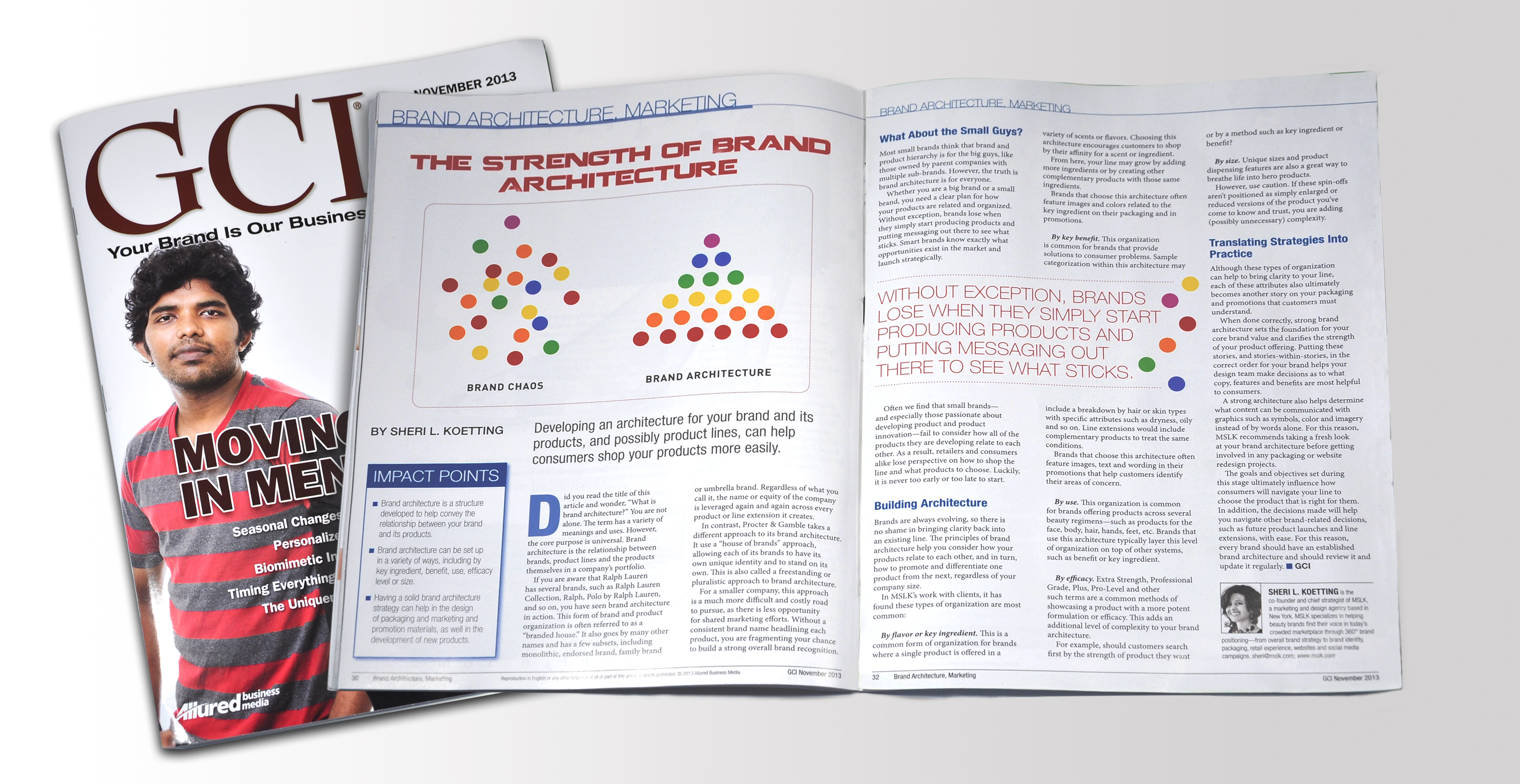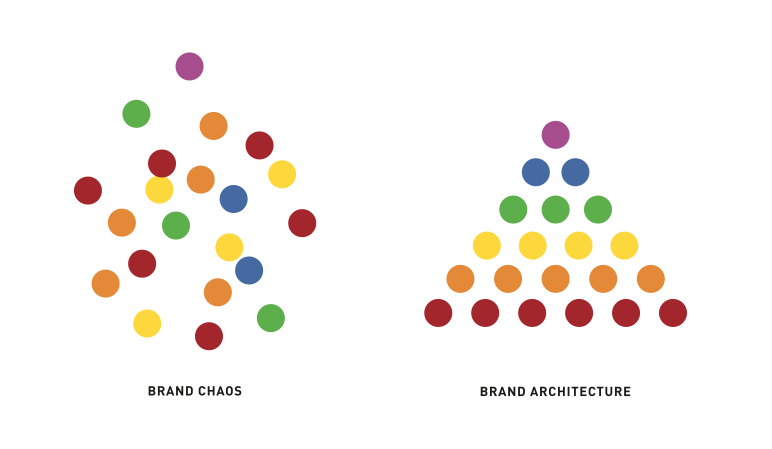GCI Article: The Strength of Brand Architecture
A clear understanding of how each of your products relate to each other, helps customers navigate your product line to finding the product to fit their needs. GCI beauty magazine asked us to explore how Brand Architecture is relevant to large and small brands in their November 2013 issue, “Your Brand is Our Business”. A recap of this article is below.
The term “Brand Architecture” has variety of meanings and uses. However, the core purpose is universal. Brand Architecture is the relationship between brands, product lines, and products themselves in a company’s portfolio.
If you are aware that Ralph Lauren has several brands, such as Ralph Lauren Collection, Ralph, Polo by Ralph Lauren, etc. you have seen brand architecture in action. This form of brand and product organization is often referred to as a “branded house”. It also goes by many other names and has a few subsets, including Monolithic, Endorsed Brand, Family Brand, or Umbrella Brand. Regardless of what you call it, the name or equity of the company is leveraged again and again across every product or line extension it creates.
In contrast, Procter and Gamble take a different approach to their brand architecture. They use a “house of brands” approach, allowing each of their brands to have their own unique identity and stand on its own. This is also called a Freestanding or Pluralistic approach to brand architecture. For a smaller company, this approach is a much more difficult and costly road to pursue, as there is less opportunity for shared marketing efforts. Without a consistent brand name headlining each product, you are fragmenting your chance to build a strong overall brand recognition.
Whether you are a big brand or a small brand, you need a clear plan for how your products are related and organized. Without exception, brands lose when they simply start producing products and putting messaging out there to see what sticks. Smart brands know exactly what opportunities exist in the market and launch strategically.
What about the small guys?
Most small brands think that brand and product hierarchy is for the big guys, like those outlined above, owned by parent companies with multiple sub-brands, but the truth is brand architecture is for everyone.
Often we find that small brands, especially those passionate about developing product and product innovation, fail to consider how all of the products they are developing relate to each other. As a result, retailers and consumers alike lose perspective on how to shop the line and what products to choose. It is never too early or too late to start. Brands are always evolving, so there is no shame in bringing clarity back into an existing line.
The principles of brand architecture help you consider how your products relate to each other, and in turn, how to promote and differentiate one product from the next, regardless of your company size.
In our work with clients, we’ve found these types of organization are most common:
By flavor or key ingredient
This is a common form of organization for brands where a single product is offered in a variety of scents or flavors. Choosing this architecture encourages customers to shop by their affinity for a scent or ingredient. From here your line may grow by adding more ingredients or by creating other complimentary products with those same ingredients.
Brands who choose this architecture often feature images and colors related to the key ingredient on their packaging and in promotions.
By key benefit
This organization is common for brands that provide solutions to consumer problems. Sample categorization within this architecture may include a breakdown by hair or skin types with specific attributes such as dryness, oily, etc. Line extensions would include complimentary products to treat the same conditions.
Brands who choose this architecture often feature images, text and wording in their promotions which help customers identify their areas of concern.
By use
This organization is common for brands offering products across several beauty regimens such as products for the face, body, hair, hands, feet, etc. Brands who use this architecture typically layer this level of organization on top of other systems, such as benefit or key ingredient.
By efficacy
Extra Strength, Professional Grade, Plus, Pro-Level, etc. are common methods of showcasing a product with a more potent formulation or efficacy. This adds an additional level of complexity to your brand architecture. For example, should customers search first by the strength of product they want, or by another method such as key ingredient or benefit?
By size
Unique sizes and product dispensing features are a great way to breathe life into hero products. However, use caution. If these spin-offs aren’t positioned as simply enlarged or reduced versions of the product you’ve come to know and trust, you are adding complexity.
Translating these strategies into practice
Although these types of organization help to bring clarity to your line, each of these attributes ultimately becomes another story on your packaging and promotions that customers must understand.
When done correctly, strong brand architecture sets the foundation for your core brand value and clarifies the strength of your product offering. Putting these stories, and stories-within-stories, in the correct order for your brand helps your design team make decisions as to what copy, features, and benefits are most helpful to consumers. A strong architecture also helps determine what content can be communicated with graphics such as symbols, color, and imagery instead of words alone. For this reason we recommend taking a fresh look at your brand architecture before any packaging or website redesign project.
The goals and objectives set during this stage ultimately influence how customers will navigate your line to choose the product that is right for them. In addition, the decisions made will help you navigate other brand-related decisions such as future product launches and line extensions with ease. For this reason we recommend every brand have an established brand architecture, and update it regularly.


